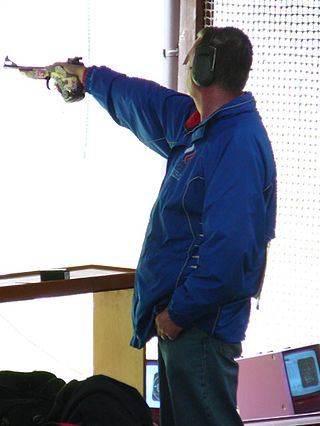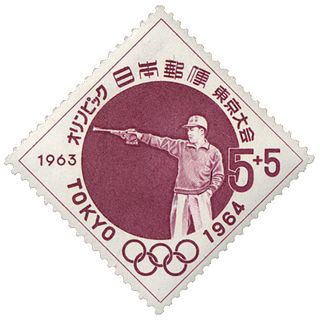
Shooting sports is a group of competitive and recreational sporting activities involving proficiency tests of accuracy, precision and speed in shooting — the art of using ranged weapons, mainly small arms and bows/crossbows.

50 meter pistol, formerly and unofficially still often called Free Pistol, is one of the ISSF shooting events. It is one of the oldest shooting disciplines, dating back to the 19th century and only having seen marginal rule changes since 1936. It is considered to provide some of the purest precision shooting among the pistol events. The target of this event has not changed since 1900, and the 50m distance has remained the standard since 1912. The sport traced back to the beginning of indoor Flobert pistol parlour shooting in Europe during the 1870s.

10 metre air rifle is an International Shooting Sports Federation (ISSF) shooting event, shot at a bullseye target over a distance of 10 meters using a 4.5 mm (0.177 in) calibre air rifle with a maximum weight of 5.5 kg (12.13 lb). It is one of the ISSF-governed shooting sports included in the Summer Olympics since the 1984 Los Angeles Games.

The ISSF World Shooting Championships are governed by the International Shooting Sport Federation. World Shooting Championships began in 1897, after the successful 1896 Summer Olympics, and although the ISSF was not founded until 1907, these early competitions are still seen by the organization as the beginning of a continuous row of championships. By this logic, the 2006 competition in Zagreb was called the 49th ISSF World Shooting Championships. These championships, including all ISSF shooting events, are held every four years since 1954. For the shotgun events only, there is an additional World Championship competition in odd-numbered years. These extra competitions are not numbered. In running target, there will be World Championships in Olympic years.

The men's individual competition with free revolver event was one of the competitions in the Shooting at the 1900 Summer Olympics events in Paris. It was held on 1 August 1900. 20 shooters from 4 nations competed, with five shooters per nation. Medals were given for individual high scores, and the scores of the five shooters were summed to give a team score for the team event. The target designed for this competition is still being used today. The event was won by Karl Röderer of Switzerland, with his countryman Konrad Stäheli taking bronze. Between them was Achille Paroche of France with silver.

The men's 300 metre free rifle standing event was one of five free rifle events of the competitions in the Shooting at the 1900 Summer Olympics events in Paris. It was held from August 3 to August 5, 1900. 30 shooters from 6 nations competed, with five shooters per team. Medals were given for individual high scores in each of the three positions, overall individual high scores, and the scores of the five shooters were summed to give a team score. The standing position was won by Lars Jørgen Madsen of Denmark, with Ole Østmo of Norway taking silver and Charles Paumier of Belgium bronze.

The men's 300 metre free rifle kneeling event was one of five free rifle events in shooting at the 1900 Summer Olympics in Paris. It was an individual kneeling position event, and competitors' scores also counted towards the individual and team three-position events. It was held from 3 to 5 August. There were 30 competitors from 6 nations, with each nation having a team of 5 shooters. Medals were given for individual high scores in each of the three positions, overall individual high scores, and the scores of the five shooters were summed to give a team score. The kneeling position was won by Konrad Stäheli of Switzerland, with Emil Kellenberger of Switzerland and Anders Peter Nielsen of Denmark tying for silver.

The men's 300 metre free rifle prone event was one of five free rifle events of the competitions in the Shooting at the 1900 Summer Olympics events in Paris. It was held from August 3 to August 5, 1900. 30 shooters from 6 nations competed, with five shooters per team. Medals were given for individual high scores in each of the three positions, overall individual high scores, and the scores of the five shooters were summed to give a team score. Achille Paroche of France won the gold medal in the prone event, with Anders Peter Nielsen of Denmark taking silver and Ole Østmo bronze.

The men's ISSF 25 meter rapid fire pistol was a shooting sports event held as part of the Shooting at the 1924 Summer Olympics programme. It was the fifth appearance of the event. The competition was held on 28 June 1924 at the shooting ranges at Versailles. 55 shooters from 17 nations competed. Nations were limited to four shooters each. Henry Bailey won the United States' second consecutive championship in the event. Sweden also earned the same medal as in 1912, with Vilhelm Carlberg's silver. Lennart Hannelius took bronze in Finland's debut in the event.
The men's 100 meter running deer, single shots was a shooting sports event held as part of the Shooting at the 1924 Summer Olympics programme. It was the fifth appearance of the event. The competition was held on 30 June 1924 at the shooting ranges at Versailles. 32 shooters from 8 nations competed.
The men's 100 meter team running deer, single shots was a shooting sports event held as part of the Shooting at the 1924 Summer Olympics programme. It was the fourth appearance of the event. The competition was held on 2 July 1924 at the shooting ranges at Versailles. 25 shooters from 7 nations competed.
The men's 100 meter running deer, double shots was a shooting sports event held as part of the Shooting at the 1924 Summer Olympics programme. It was the fourth appearance of the event. The competition was held on 1 July 1924 at the shooting ranges at Versailles. Thirty one shooters from eight nations competed.
The men's 100 meter team running deer, double shots was a shooting sports event held as part of the Shooting at the 1924 Summer Olympics programme. It was the third appearance of the event. The competition was held on 3 July 1924 at the shooting ranges at Versailles. 25 shooters from 7 nations competed.

The men's 30 metre rapid fire pistol, labeled the "revolver" in the Official Report and often described as a "military pistol" event was a shooting sports event held as part of the Shooting at the 1920 Summer Olympics programme. The International Shooting Sport Federation identified this event as the fourth appearance of an individual 25 metre rapid fire pistol event; it was the second time the distance was 30 metres. In 1896 the distance was 25 metres; in 1900, 20 metres. The competition was held on 3 August 1920. 11 shooters from 3 nations competed. The event was won by Guilherme Paraense in Brazil's debut in the event; it was Brazil's first Olympic gold in any event. American Raymond Bracken took silver, while Swiss shooter Fritz Zulauf earned his nation's first medal in the event.

The men's trap was a shooting sports event held as part of the Shooting at the 1920 Summer Olympics programme. It was the fourth appearance of the event. The competition was held on 23 and 24 July 1920 and 18 shooters from seven nations competed. The United States swept the podium ; it was the second sweep in the men's trap. Mark Arie took the gold medal, the second consecutive victory by an American. Frank Troeh earned silver, while Frank Wright finished with bronze. Arie also received Lord Westbury's Cup, a challenge prize previously awarded in 1908 and 1912 to the winners of those years' men's trap competitions.

The men's ISSF 25 meter rapid fire pistol was one of the fifteen shooting events at the 1996 Summer Olympics. Ralf Schumann defended his title from Barcelona, setting two new Olympic records. Schumann was the third man to successfully defend an Olympic title in the rapid fire pistol, and the first to win three or more medals in the event; he would finish with three golds and five total medals. Emil Milev of Bulgaria (silver) and Vladimir Vokhmyanin of Kazakhstan (bronze) each won their nation's first medal in the event, though Vokhmyanin was a repeat bronze medalist, making him the 10th man to win multiple medals in the event. There were 23 competitors from 19 nations. Nations had been limited to two shooters each since the 1952 Games.

The men's ISSF 50 meter pistol was a shooting sports event held as part of the Shooting at the 1952 Summer Olympics programme. It was the eighth appearance of the event. The competition was held on 25 July 1952 at the shooting ranges in Helsinki. 48 shooters from 28 nations competed. The maximum number of shooters per nation was reduced to 2, from 3 in previous Games. The event was won by Huelet Benner of the United States, the nation's first victory in the event since 1920. Silver went to Ángel León Gozalo of Spain and bronze to Ambrus Balogh of Hungary; they were the first medals in the free pistol for both nations.

The men's ISSF 50 meter pistol was a shooting sports event held as part of the Shooting at the 1960 Summer Olympics programme. It was the tenth appearance of the event. The competition was held on 5 and 6 September 1960 at the Umberto I Shooting Range in Rome. 67 shooters from 40 nations competed. Nations had been limited to two shooters each since the 1952 Games. The event was won by Aleksey Gushchin of the Soviet Union, as the Soviet team finished 1–2 with Makhmud Umarov repeating as silver medalist. Yoshihisa Yoshikawa of Japan took bronze.

The men's trap was a shooting sports event held as part of the Shooting at the 1960 Summer Olympics programme. It was the eighth appearance of the event. The competition was held from 5 to 9 September 1960 at the shooting ranges in Rome. 66 shooters from 38 nations competed. Each nation could send up to two shooters. The event was won by Ion Dumitrescu of Romania, the nation's first medal in the men's trap. The defending champion, Galliano Rossini of Italy, took silver this time to become the first person to earn multiple medals in the trap competition. Soviet shooter Sergei Kalinin received bronze.

The men's ISSF 50 meter pistol was a shooting sports event held as part of the Shooting at the 1964 Summer Olympics programme. It was the eleventh appearance of the event. The competition was held on 18 October 1964 at the shooting ranges in Tokyo. 52 shooters from 34 nations competed. Nations had been limited to two shooters each since the 1952 Games. The event was won by Väinö Markkanen of Finland, the nation's second victory in the event. American Franklin Green took silver, returning the United States to the podium in the event after a one-Games absence. Yoshihisa Yoshikawa of Japan repeated as bronze medalist, the fourth man to earn multiple medals in the free pistol.











